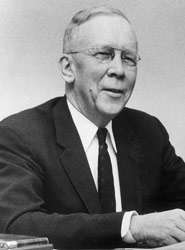Walter Stephenson Newman
| Walter Stephenson Newman | |
|---|---|
 | |
| 10th President of Virginia Polytechnic Institute and State University | |
|
In office 1947–1962 | |
| Preceded by | John Redd Hutcheson |
| Succeeded by | T. Marshall Hahn |
| Personal details | |
| Born |
July 20, 1895 Woodstock, Virginia |
| Died |
July 28, 1978 (aged 83) Blacksburg, Virginia |
Walter Stephenson Newman (July 20, 1895 – June 29, 1978) was the tenth President of Virginia Tech, serving from 1947 until 1962.[1] Newman brought an impressive body of experience to the job when he took over as president on September 1, 1947. An alumnus with a master’s degree in agriculture, Newman had been a pioneering vocational agriculture teacher in Virginia, a member of the VPI agricultural education faculty, state assistant superintendent of public instruction, state supervisor of agricultural education, and president of the Richmond Chapter of the VPI Alumni Association. In 1925 Newman along with three other agriculture teachers at VPI, Henry C. Groseclose, Edmund Magill, and Harry Sanders, had founded a club for farm boys at the school that in 1928 became the National FFA Organization.
Newman’s presidency—sometimes called the era of good will—brought unparalleled growth in academic and athletic programs, enrollment, and the physical plant. It also brought numerous changes in administrators, department heads, and faculty. Generally credited with laying the groundwork for Virginia Tech’s development into a major state university, Newman provided an expanded vision of college education. Under him VPI strengthened its offerings and proposed degrees in the humanities, broadened its social sciences courses, added graduate degree programs, organized many new departments, created new schools of home economics and business, and initiated cooperative education and graduate-level teacher training programs. Newman also recommended that architecture, then joined with engineering, be established as a separate school.
Growth of the corps of cadets, however, remained a problem as many cadets moved into the civilian student body at the end of the mandatory two years in the corps. The board of visitors began studying military life on campus, and a controversy developed over the military role. In 1951-52 a group of students, mostly veterans, started a “The Corps Must Go” movement. But the board decided to maintain both military and civilian student bodies.
The physical plant changed dramatically under Newman, with more than $20 million spent for 25 principal buildings. In 1949 the college discontinued Rad-Tech, bringing all students onto the main campus. Later, Henderson Hall was completed to house an enlarged infirmary, the War Memorial was erected, the Mall was constructed, the coliseum and Newman Library were built, and other buildings were erected or expanded. Academic Buildings One and Two, both campus landmarks, were demolished to make room for new dormitories; the remaining houses on Faculty Row were removed to make room for laboratories and classrooms; the landmark water tower was disassembled; and the college added a baseball field and golf course. Appalachian Power Company gave VPI a 90-acre camp site on Claytor Lake, and the McCormick family donated the Rockbridge County farm where Cyrus McCormick invented the reaper. Meanwhile, the college helped alleviate its water supply problems by working with Blacksburg and Christiansburg to form the VPI-Blacksburg-Christiansburg Water Authority.
Believing that most Virginians knew little about the college’s capabilities for helping the commonwealth, Newman urged members of the board of visitors to spread the word about the school’s services and needs. His own straightforward, friendly, and earnest manner created many friends for the college, and his presentations on the school led to increased positive coverage by the media and improved financial support from the state.
During the 1950s and early 1960s, the administration gave permission for students to drive cars on campus; the Highty-Tighties won three consecutive first-place awards at presidential inauguration parades; students initiated a system of rating professors; a tenure policy was adopted; the college admitted its first black student, Irving Linwood Peddrew III; the Alumni Fund Council established the William E. Wine Award for Faculty Achievement; Newman began referring to VPI as a university-type institution; and the school hired its first director of development. In 1958, Virginia Tech became the first traditionally white southern college to graduate an African American, with the graduation of Cadet Charles Yates (class of 1958).
Newman’s health began to decline, and he retired June 30, 1962. He was named president emeritus by the board of visitors and an honorary member of the Class of ’62. In 1977 he became the first recipient of Virginia Tech's William H. Ruffner Medal, the college’s highest honor. He lived in Blacksburg until his death on June 29, 1978.
Newman Hall, a residence hall on the Virginia Tech campus is named in honor of Newman.
References
- ↑ "Walter Newman, 83, President Of Virginia Tech for 15 Years". The Washington Post. July 1, 1978. Retrieved 2009-11-20.